|
Michael McFadyen's Scuba Diving - Sailing to Queensland, Winter 2015 - Part 10
Latest update 8 September 2015.
Continued from last part
Thursday 27 August 2015 - John Brewer Reef to Back Numbers Reef
 | | Magnetic Island, Horseshoe Bay at bottom, John Brewer Reef just below top on right, top right is Back Numbers Reef |
It was calm in the middle of the night but around 0500 it got a bit rolly when the tide got close to high. Veto woke Michael up once about 0330 to go to the toilet. She did this but when she came back to bed she vomited a few times, luckily nothing came out. She seems okay when we get up at 0720.
We have breakfast and at 0835 we pull up the anchor and once we are away from the reef we pull out the screecher. The wind is 11 knots from the east and we are close-hauled as we sail towards Back Numbers Reef which is about 8 nautical miles away. We are doing about 4.5 knots with 1 knot of current behind us.
 |  |
| Kelly and Michael with part of the reef behind | Catlypso from the sandy cay on Back Numbers Reef |
We are specifically aiming for a spot off the south-western corner of the reef where a large boat called Mascarin III anchored last night. It had AIS so we saw where it stopped and marked this point on the chartplotter. We have a really nice sail, the seas are almost totally flat and we make between 3.5 and 5.0 knots depending on the actual strength and direction of the wind (which changes a bit).
At 1025 we pull in the screecher and motor in towards the reef. The spot where the boat anchored is way too deep for us to anchor, 26 metres. The sun is now high enough for us to see the reefs and bommies, so we slowly motor closer to the main reef. The charts once again are of no use, the detail is next to hopeless. We have some Google Maps photos of the reef, but they are also not too sharp.
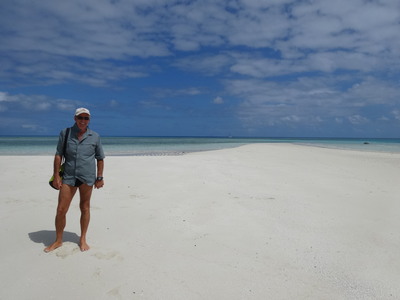 | 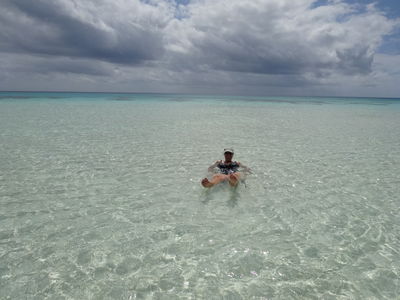 |
| Michael on the sand cay with Catlypso in the background | Kelly having a swim |
We pass a bommie that comes up from 26 metres to the surface, it looks like it might be a nice dive site. Too bad we are alone, it would be too dangerous to leave Catlypso and Thunderbird 2 unattended while we both dived and also not good to motor that far downwind in Thunderbird 2 in case its motor died.
We see that there is a sort of bay on this corner of the reef and we motor right in, going around quite a few bommies. We come to a sandy spot about 13 metres deep with bommies far enough away from the middle to safely anchor. We are anchored by 1055.
This really is a beautiful reef, with this bay/lagoon quite protected, unlike last night's spot. We have reef on three sides. To the north of us there is a small sandy cay which will probably totally cover at high tide. After making sure we are securely anchored (and a cup of tea), we motor across the shallow reef to the sandy cay. Veto has a run and seems quite energetic again. She is not fully over whatever has affected her, but she is much better.
 | 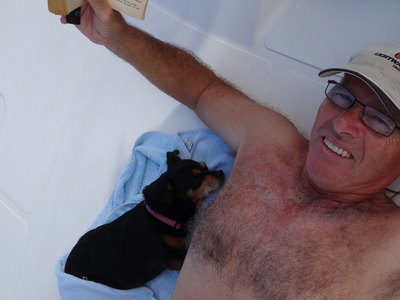 |
| Catlypso from the water | Michael reading and Veto sleeping on the foredeck |
We have a bit of a swim in the crystal clear blue water before motoring around the long way to Catlypso. We have another swim at the boat as well. After lunch, we sit on the foredeck in the sun reading. Both of us say "do you hear a plane?" and then we sit up and see a Customs aircraft heading straight at us from ahead. It passes over at about 200 feet. We think they will call us on the VHF but they do not, simply climbing and turning to the north-east.
We have head the planes before calling boats and seen one quite high up, but this is the first time we have been buzzed. A pity we did not have time to take a photograph.
Michael adds 50 litres of water to the tank we are using (so he has containers to fill in two days when he has to run the watermaker) and puts 22 litres of diesel in the tank. Our fuel economy is a very constant 2.2 litres per engine hour and we have only used 22 litres in the past two weeks.
Michael also checks that the television is receiving channels, as tonight South Sydney is playing Brisbane in the second last round of the rugby league. Souths need to win to stay in the top four. It is picking up most channels, great considering that at Horseshoe Bay we could get nothing.
We have sundowners and then Kelly cooks a roast turkey roll with vegies. A great meal. We watch the football, Souths get killed again, this time 42-18. They played so bad, amazing considering how they played two weeks ago when we went and watched them in Townsville.
Stats:
Friday 28 August 2015 - Backnumbers Reef to Casement Bay, Great Palm Island
 | | Back Numbers Reef top right, Palm Island bottom left, Orpheus Island top left |
Well, plans are made to not work out aren't they? Today we were going to head off to another couple of reefs and stay overnight on one, depending on what we found there. However, Veto once again was not well, waking Michael up three times to go to the toilet. Her poos were again bad, very sloppy
We get up at 0710 and Michael puts on the generator as for some reason our batteries are showing 11.7 volts despite allegedly having over 750 amp hours left. Michael decided ages ago that the amp hour part of the meter is just not accurate in recording how power comes in and goes out. We run this for 75 minutes till we decide to leave.
After a few discussions, we decide to head back closer to land. We decide to go to Great Palm Island and then, depending how Veto is tomorrow, perhaps go to Townsville to find a vet. We depart at 0845 and weave our way out through the bommies to open water.
As we depart, the Customs plane (now called Border Control) flies over us fairly high and then a few minutes later comes back again at 200 feet like it did yesterday. It does another flypast higher and then goes north. We later hear it talking to the boat that was anchored here yesterday morning, asking who they are, where they are based and where they are going. We wonder why they did not question us or the two other boats anchored here this morning.
 | 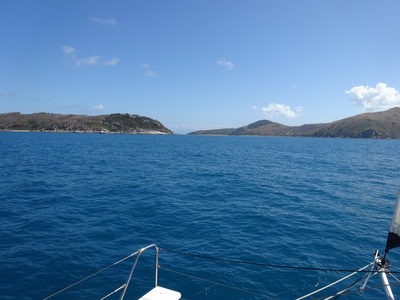 |
| Great Palm Island as we approach from the east | Great Palm Island at left, Calliope Passage in the middle and Curacoa Island at right |
The wind is 10 to 12 knots from the east so it is coming over our left shoulder. We motorsail with the screecher out, making 5.8 to 6.2 knots. As we pass to the south of Fore and Aft Reef, we hit a current of 1.5 knots against us which then drops to 0.5 knots a bit further on. At 0940 Michael decides to put the watermaker on as since we are running an engine, we might as well use the power to create water.
We probably could have sailed all the way without an engine, but as we needed to boost the batteries, it was not totally wasted. The seas are pretty calm, even when the wind picks up for a while to 15 knots. Our speed goes up to over 7 knots when this happens.
At 1215 we get a hit on Kelly's fishing line, but when she goes to reel it in it is gone. At 1305 another fish hits the lure. The reel runs out and Kelly has a lot of problems getting the rod out of the holder even though Michael cuts the engine. She just starts to play the rod when the line snaps. It was 30 pound breaking strain we think, so it must have been a big fish. The first real chance to catch a fish of the trip.
 |
| A panoramic photograph of Great Palm Island's western side. The town is at left and the airport in the gap on right |
Great Palm Island is an Aboriginal community and you are not permitted to land without a permit. The island is quite large, about 14 kilometres east to west (although it is not this wide for its whole length) and 14 kilometres south-east to north-west (the same). It is also very hilly. It can be seen from well over 40 nautical miles.
We turn off the watermaker after four hours, making about 90 to 100 litres. We are going to go between Great Palm and Curacoa Islands through Calliope Passage. There is a raging current here, thankfully going with us. It is 4 knots and we are making almost 10 knots. The current drops off as we get further down Great Palm Island.
We decide to anchor in Casement Bay off the airport which is just to the south of the township. We pull in the screecher as we pass the town and motor around till we anchor in 5 metres. It is very calm, even though there is 15 knots of wind coming over the airport. The current is stronger than the wind, but this is not causing a problem. Quite a few light aircraft land and take off in the first hour we are here, but then no others.
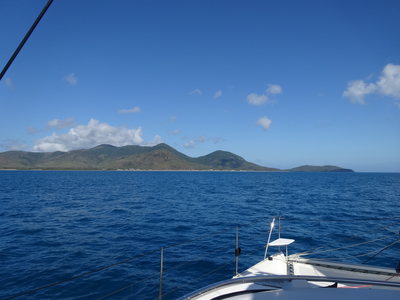 |  |
| The eastern and populated side of Great Palm Island | The moon rises over Great Palm Island |
The boat's batteries are now back at 100% according to the ammeter but the voltage is only 12.7 which is not full (12.8 is full). Michael will keep an eye on this to see what can be done to make it work better.
We have showers and sundowners as the almost full moon rises over Great Palm Island. We have tacos for dinner. This is a very nice anchorage, it is just a pity that we cannot go ashore.
Stats:
Saturday 29 August 2015 - Great Palm Island to Orpheus Island
At 0245 it rained for about 10 minutes, we have had so little rain over the past two months (since before we got to Whitsundays). It was extremely calm overnight. Veto gets Michael up at 0630 to go to the toilet, she does a mostly solid poo and we think she is finally over the illness that has affected her for the past four days. However, we are wrong, she ends up spending the next two hours doing sloppy poos all over the place.
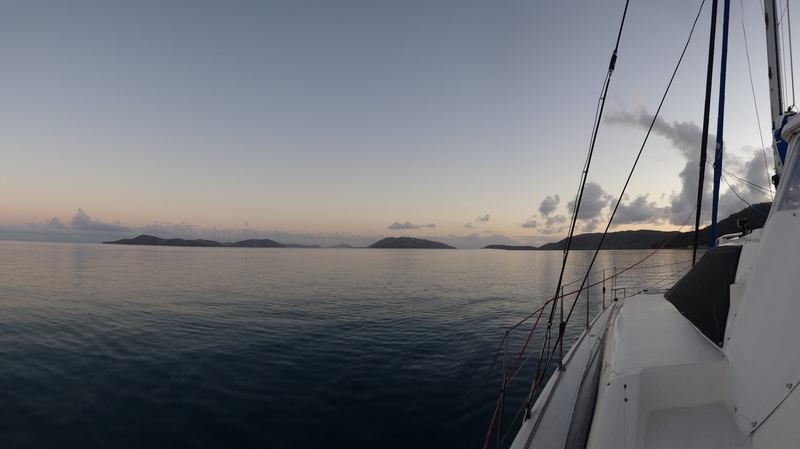 |
| Sunrise from Catlypso looking towards the north-west from our anchorage in Casement Bay |
We get up at 0820 and have breakfast. By now Veto is a little bit better (how many times have we said this over the past few days?). Despite this, we decide that we have to go back to Townsville on Monday to take her to a vet. Kelly finds one on the internet and phones to make an appointment. She also books us into the marina for a night.
After 0900 she seems to have improved as she eats a chicken stick. We decide to go to Orpheus Island today and then tomorrow to backtrack to Rattlesnake Island which will give us a shorter run to Townsville on Monday morning.
We head off at 1000 and try to sail, but the wind is only 8 to 9 knots from almost behind us. This is not enough to go more than about 3 knots considering there is a little bit of current against us. We motorsail at 1800 rpm on one engine and make 4.5 to 5.0 knots. After we round the southern end of Fantome Island, the wind dies off and we pull in the screecher. We lose no speed, just shows it was not doing much.
 |  |
| Catlypso in Juno Bay | Orpheus Island Resort |
We motor to the northern end of Fantome Island and at 1135 anchor off the old leper colony in Juno Bay. The tide is going towards low so there is a lot of fringing coral reef between us and the shore. We take Thunderbird 2 and motor over to a part of the beach that is easier to access. We go for a short walk before returning. We could not stay long as Thunderbird 2 would have ended up stranded.
We head off at 1240 and motor around the bottom of Orpheus Island and up past the Yanks Jetty (which appears to be broken and not connected to the shore) and then past the Orpheus Island Resort ($1400 a night per room minimum) and the AIMS (Australian Institute of Marine Studies) Research Station. We enter Pioneer Bay and then Little Pioneer Bay and take one of the four marine park moorings in this bay. Three are at the northern end (where we are) and one is at the southern end.
This is a really nice spot, with views to the southern end of Hinchinbrook Island (reaches to 1000 metres) and the mainland. We have a swim as it is very hot. We spend the rest of the afternoon reading.
 | 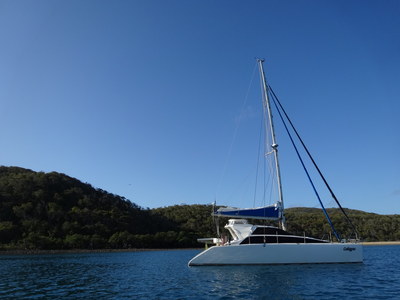 |
| The view from Catlypso to the south in Little Pioneer Bay | Catlypso moored in Little Pioneer Bay |
At 1630 we go to the beach as the tide has come in enough to get across the coral reef. This is a nice beach, but it has one of the poorest camping areas we have ever seen. I have no idea who would want to camp here, the space would fit one small tent and that is it.
Back on Catlypso we have showers, sundowners and then Michael cooks a flat lamb on the barbecue. It is really nice with a pasta dish. We really should have come up here earlier, it is a nice place. Too bad we need to leave tomorrow.
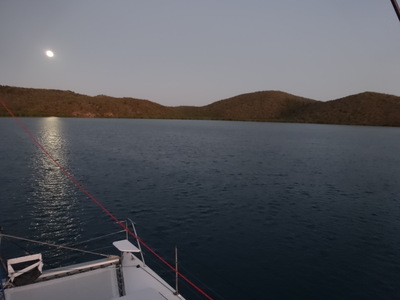 |  |
| The moon rises over Little Pioneer Bay at Orpheus Island | The full moon is high up but it is almost like daylight |
Stats:
Sunday 30 August 2015 - Orpheus Island to Rattlesnake Island
 | | Orpheus Island top, Rattlesnake Island is marked, Townsville bottom |
It was extremely calm overnight till about 0530 when there was a little bit of rolling, but nothing really. We get up at 0710 and Michael takes Veto to shore. She does a solid poo, the first for six days. She also runs around very energetically, so it looks like she might finally be over what has been affecting her.
We have breakfast and at 0805 we leave the mooring and motor out to the west a bit. The wind at this stage is from the south-west so we need to get a bit further out before we can sail as we are going to need to head a little east of south.
We pull up the main sail and once we are out far enough, we turn and pull out the genoa. We soon replace this with the screecher as we do not have to sail as close-hauled as we thought. There is about 10 knots of wind and we are doing about 5 knots, but it drops to 7 knots and we are only doing 4 knots.
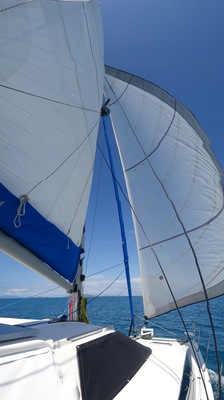 |  |
| Sailing south past Palm Island | Kelly and Veto at the helm |
The wind then dies totally and turns to the south, so we pull in the screecher and motor sail with the main up (we cannot be bothered to pull it down) doing 5.4 knots. Kelly decides to defrost the refrigerator as we go along as it is quite a while since we last did it and the freezer section is full of ice again.
At 1155 the wind turns to the north-east so we put the screecher back out. We are doing 4.7 to 5.4 knots in 10 knots of wind. The seas are absolutely flat and we have a great sail. We pass by Havannah Island and then come around Lorne Reef which is to the west of Rattlesnake Island. Once we are off the southern side of the island, we pull in the sails and motor over to look for an anchorage.
 |
| A panoramic photograph of Rattlesnake Island from the western sand spit |
Normally you anchor on the northern side of the island but as the wind is from the north-east (and predicted to stay that way all night), we want to anchor on the southern side. We head in towards the beach but there is a bit of roll here from small swells coming around the eastern side. We motor back towards the western point and end up anchoring off the sand spit in 8 metres. It is a lot calmer here and gets better as the evening goes on.
Rattlesnake Island and adjacent Herald Island are part of a defence department bombing range. However, it is not in use today, so we are safe. At 1600 we go to the sand spit and Veto has a run around (and another solid poo). We figure it is safe here, no unexploded bombs.
 |  |
| Approaching Rattlesnake Island | Enjoying sundowners at Rattlesnake Island |
When we get back to Catlypso we have showers and sundowners. Kelly makes a curry using the left over lamb from last night. Even though Veto appears to be better, we are still going to go to the marina tomorrow and take her to the vet. We spend a comfortable night at anchor here.
Stats:
Monday 31 August 2015 - Rattlesnake Island to Townsville
It was calm overnight, the wind died off almost totally. We get up at 0630 and Michael takes Veto to the sandspit again. She has a good run and does some more solid poos. It looks like she is really over her sickness. We have tea and coffee and depart at 0730.
There is little wind this morning and it is also on the nose, so we have to motor all the way to Townsville. We could have only sailed the last 15 minutes when the wind shifted to the north-east from its southerly or south-westerly direction earlier. We tie up at the marina at 1115.
 | 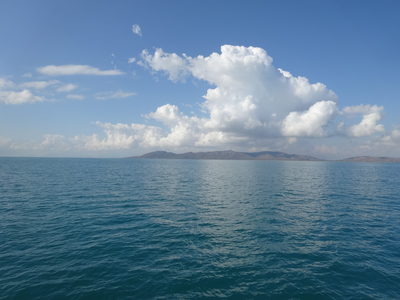 |
| Magnetic Island as we pass to the west | Approaching Townsville from the north |
Kelly goes off to book in and put some washing on. Meanwhile, Michael flushes the watermaker and fills our water tanks (only one really needed water). After lunch, while Kelly finishes off the washing/drying, Michael cleans the bird crap that was dropped on the port side of the cabin a few days ago. He also drains the water from the stern section of the starboard bilge where we have a slight leak.
Michael later hoses down the whole boat, including the cockpit. This is the first decent wash she has had in a few months. At 1510 we go to the marina office and get a lift to the vets. It was very kind of the lady there to offer to take us. The vet looks at Veto and declares that she is fully recovered from whatever was ailing her. She gives us some antibiotics in case she has a reoccurrence. Veto's weight has dropped from 3.7 kg in Cannonvale about five weeks ago to 3.35 kg today. Before we left home she was about 4.0 kg. Looks like we will need to fatten her up a little.
 |  |
| The fireworks display went for about 10 minutes | The casino is the building at right |
We walk back, stopping at Coles where Kelly does some shopping while Michael stays outside with Veto. We get back to Catlypso at 1720. Kelly makes cannelloni for dinner, we have showers and then sundowners. After dinner there is a fireworks display at the casino which is next to the marina. It was not too bad, but scared the hell out of Veto.
After this we take Veto for another walk, this time in the park next to The Strand.
Stats:
Tuesday 1 September 2015 - Townsville to Cape Bowling Green
It rained a few times during the night and is very threatening when we get up at 0645. We make a cup of tea and coffee and Michael takes Veto for a quick walk. We leave at 0730 and motor out of the marina. As we exit the breakwater, we see Australia's newest and largest warship, HMAS Canberra is leaving the port.
The Canberra exits the port exactly as we come out into open water. We have to cross her path, but she is moving much quicker than us and we pass behind. The weather is not looking good, there is rain all around and we have a few showers hit us as we motor along. The wind is not only almost non-existent, what there is is coming from the wrong direction to enable us to put up our sails.
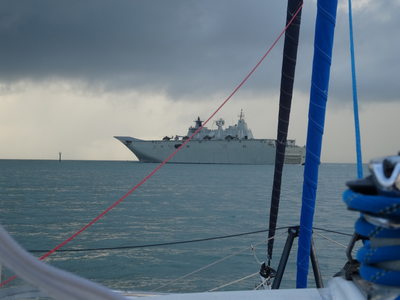 | 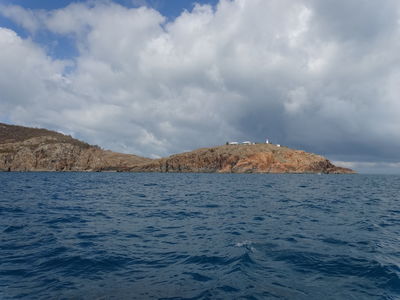 |
| HMAS Canberra crosses in front of us | Cape Cleveland with its lighthouse and lighthouse keepers houses |
We motor towards Cape Cleveland in a slightly sloppy sea. Another catamaran, Alexis, comes out behind us and passes us after about 30 minutes as they are going about 0.2 knot faster than us. We are making about 4.5 knots. At 0845 the wind turns to the south-east and goes up to 10 to 11 knots. We put out the main and the screecher and turn off the engine. We are making 4.5 to 5.5 knots.
However, at 0915 the wind drops and we have to put an engine back on, we are now doing 6.2 knots. Fifteen minutes later we have a mini rain squall hit us and the wind goes easterly, so we pull in the screecher and continue with just the main up. As we approach Cape Cleveland, Michael spots some humpback whales ahead.
We catch up with them just after passing the headland. There is a large male, a smaller female and a tiny baby. The male is leaping out of the water and fin slapping. The baby is also leaping out of the water. We pass about 100 metres from them. Another great experience! We go between Four Foot Rock and Salamander Reef and head for just inside Cape Bowling Green.
 |  |
| The large male humpback leaps out of the water | The baby leaps with one of its parents behind |
We pull out the genoa just past here and get an extra quarter of a knot. At 1255 we swap to the screecher as the wind has now moved to the north-east. We turn off the engine and are sailing at 4.8 knots in 9 to 10 knots of wind. We are pointing five degrees south of our course, but that is okay. A little later the wind comes up to 15 to 17 knots and we are now doing 7.5 knots. This is better.
We sail the rest of the way to Cape Bowling Green and just before we get there we pull in the sails. Cape Bowling Green is a long, thin and low sand spit with some vegetation in spots. We motor over towards the tip of the sand spit and anchor in 2.1 metres (tide still had about 0.6 metres to go down). The other cat is already anchored here and soon three monohulls and another cat join us.
Michael adds 44 litres of diesel from containers to the main tank. The fuel economy from Sydney has been very consistent, 2.2 litres per engine per hour. So far we have used about 647 litres ($894).
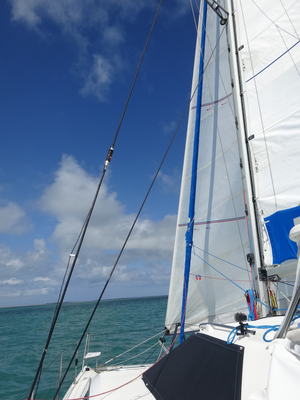 |  |
| Sailing towards Cape Bowling Green which can be seen | Catlypso at left and some of the other
boats anchored off Cape Bowling Green |
At 1600 we go ashore and Veto has a great run around. While we are walking we met John and Karen from the second catamaran to come in, Two Poodles. This is a Seawind 1000 and they are from Sydney and yes, they do have two poodles on board! We have a good chat to them about their trip, they left about a month after us.
We are back on Catlypso just after 1700 and have showers and then sundowners. Michael makes a yellow curry chicken with rice and then we have strawberries and cream for dessert. It is now a little bit rolly here as the wind has turned a bit more to the east and there is a little bit of slop coming around the end of the sand spit. Hopefully it will not be too bad tonight.
Tomorrow we plan to leave at about 0600 and try to get all the way to Gloucester Passage. This is almost 80 nautical miles, so we need to average 6.5 to 7.0 knots all day to get there in daylight. If the wind is 10 to 15 knots as forecast, we should be able to make it. If it looks like we will not, we have the backup plan to go to Cape Upstart about half way. We will play it by ear.
Stats:
Wednesday 2 September 2015 - Cape Bowling Green to Cape Upstart
It was another calm night and we get up at 0530. We notice that Veto has again appeared to vomit on the bed cover. We did not hear her do this and she seems fine. Hopefully this is not a relapse. We make tea and coffee and then prepare to leave.
We pull up anchor at 0610 and motor around the tip of Cape Bowling Green and raise the mainsail. Once outside we pull out the screecher as well. Note that our chartplotter is quite inaccurate when it comes to the western extent of the sandspit, it extends far further than the chartplotter shows.
The wind is north-north-west at 15 knots and we are making 6.5 knots with an engine on. When we turn to head to Gloucester Passage, we drop to 5.7 knots. The wind soon drops to 8 knots but then goes back to north. We pull in the main as it is blocking air to the screecher. We are now doing 5.8 to 6.0 knots in 10 knots of wind (with the engine still on). As we need to average at least 6.6 knots from here to get to Gloucester Passage before 1800, we will need to decide whether to head there or go to Cape Upstart instead.
At 0840 we decide that we cannot make it by 1900, let alone 1800, so we change course to head to Cape Upstart which is about 40 nautical miles closer. Also, the forecast for the next few days will still be good for what we have to do, so it is not a hard decision to make. We also decide to pull in the screecher and put up the spinnaker.
This is only the third time we have used the spinnaker, and Kelly makes a good go of setting it up and flying it. We are doing 4.7 knots in 12 knots of wind without an engine so we leave it off. Later the wind increases to 12 to 15 knots and we are doing 5.5 to 6.5 knots. The wind later drops back to 11 knots.
 |  |
Sailing towards Cape Upstart
with the spinnaker flying | Some of the trailers used to
launch across the beach |
Kelly has been trolling since we left this morning and she gets three hits. One did not take at all but the fish followed the lure as she hauled it back in to check. The second was on for a while but came free and the third one was hooked. It eventually broke the line at the trace. We are not having much luck with the fishing!
As we approach Cape Upstart the wind increases to over 15 knots and we are doing 7.5 knots at times. A pity we did not have this wind earlier, we would have been able to make Gloucester Passage easily. We drop the spinnaker a few hundred metres from the anchorage and motor about 400 metres south of where we anchored last time.
We have a lot of problems anchoring, it takes three goes before the anchor holds. This is only the second time on this trip we have had to try to anchor more than once. Finally it holds well. It is 1350 (it took 35 minutes to anchor). After making sure we are not moving, we go ashore and Veto has a good run around. She has appeared to be perfectly fine all day, so we have no idea why she vomited earlier. There are plenty of fishers' huts here, all only accessible via boat. There does not appear to be anyone here at all.
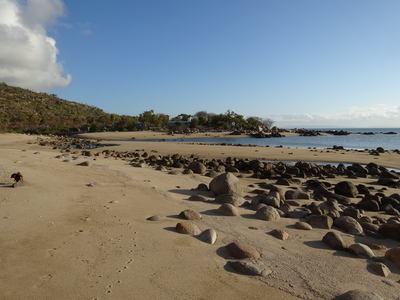 | 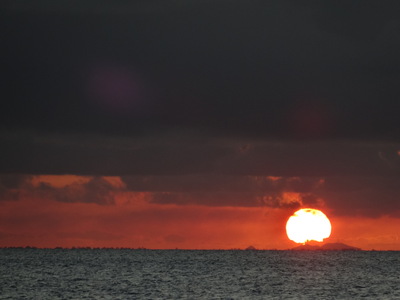 |
Some of the houses at Cape Upstart,
together with a nice bay and creek | Sunset from Catlypso at Cape Upstart |
There are two other boats anchored here, one Alexis who anchored near us last night. Eventually there will be 13 boats anchored nearby, most of which appear to be racing yachts on the way home from the Magnetic Island Race Week which finished yesterday.
It is quite choppy here as the wind is still blowing 15 to 20 knots from the north. There is little protection from this direction, but it is not too bad. Later Michael takes Veto to the beach for another run. We have showers (one advantage of having to motor for a bit), sundowners and then pumpkin gnocchi and garlic bread.
Tomorrow we will again get up early and head for Gloucester Passage where we hope to meet up with Jillian and Wayne from Walkabout.
Stats:
Thursday 3 September 2015 - Cape Upstart to Nelly Bay, Cape Gloucester
It was a bit rough during the night but not too bad. Michael slept well but Kelly said she only had an "okay" sleep. We get up at 0550 and Michael takes Veto to the beach. The first attempt was a failure when he runs aground, but he gets there eventually. After making a cup of tea and coffee, we pull up anchor and leave at 0625.
Virtually all the other boats here leave within 15 minutes either side of our departure. We motor out and pull up the mainsail as we near The Bun which is the rock off the north-western point of Cape Upstart. Once we are outside, we pull out the screecher. The wind is only 10 knots and almost behind us (it is supposed to be northerly but is almost westerly). We still have an engine on.
As we near the north-eastern point, we take down the other sails and put up the spinnaker. We are doing 6 to 7 knots but the wind changes direction and the sail is now on the wrong side. We pull it down and then put it up again, this time right in front. The wind is now varying between 8 and 16 knots and we are doing between 4 and 6.5 knots. We have the engine off and on a number of times.
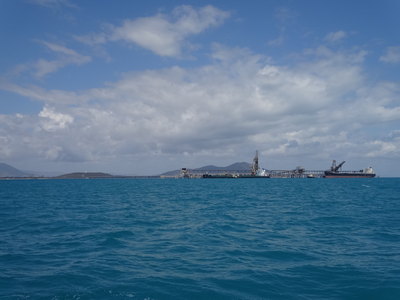 | 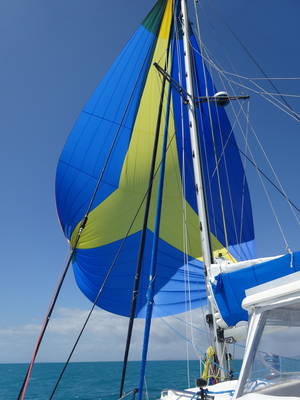 |
| Abbot Point Coal Loader | Flying the spinnaker again |
By 1100 the wind is up to 17 knots and we are going 7.5 to 8.0 knots. At 1130 we have a hit on the fishing line and Michael pulls it within 50 metres of the boat when it breaks free. It turns out that the clip on the trace has opened. Of course, we were going fairly fast as he was pulling it in and we could not slow down. Later the wind is 20 knots and we are doing around 9 to 9.5 knots and then it gets to 27 knots, we hit 11.3 knots quite a few times.
We also pass very close to the controversial Abbot Point Coal Loader. This was given approval to expand and then dump the huge amount of dredged material out on the Great Barrier Reef. As far as I recall, they are now going to put the dredged material onshore (like they should have proposed in the first place).
The wind is now constantly 25 to 27 knots (well in excess of the forecast 10 to 15 knots). As we come level with Gloucester Passage, we decide to drop the sail. We have big problems trying to pull the spinnaker down, we stuff up big time. The sock will not come down over the sail.
 |  |
| Michael attempting to pull in our first fish | Michael's hand with the rope burns |
The spinnaker goes wildly out of control, Michael burns the fingers on his right hand when the sheet (rope) runs free and the sail ends up in the water as we drop it from the top of the mast. Kelly also ends up with a dozen bruises on one arm and some minor burns on her finger tips. We also lose the nose cone off the wind generator when the sheet wraps itself around it.
The things we did right? Well, we did not wrap any of the lines that went in the water around the prop, we got the spinnaker back on the boat, wet but in one piece and we survived! The seas by now are about 2 metres. We decide to head to Sinclair Bay (south of Gloucester Passage) to anchor there as Jillian and Wayne say it is very protected. However, before we get there we decide it is too shallow for us (they have daggerboards, not mini-keels) so we turn and head north.
It is a very uncomfortable motor, we need to use both engines to make way, but cannot go at our normal speed as it is too rough. We finally make it into Gloucester Passage itself and with the wind now behind and a little protection, it is much better. We have decided to motor around to the eastern side of Cape Gloucester near Dingo Beach. There is a small island called Manta Ray (we think) that gives some protection to a spot called Nellie Bay. This is called Nelly Bay on signs on the land but Nellie in Alan Lucas's book.
It takes about one hour to get from Shag Island to the anchorage. It is not too bad here, what swell is coming in is at least coming with the wind which is only 10 to 15 knots (protected mostly by Gloucester Island). We anchor at 1615 in about 4.8 metres. We spend the next hour cleaning up, including putting the spinnaker properly back into the sock. It is too rough to take Veto to shore.
We also have had a couple of leaks. One is over our bed and came because the hatch above was not properly closed (possibly loosened by the wild spinnaker sheet). The other is on the starboard side where water seems to have been pushed up under the large side window. This will need some black silicone on it. The other is a leak we have had before, right at the port bow. We still are not sure where this is coming from. None of the leaks are major.
The one in our cabin has wet the doona, so we put it out to dry. While Kelly is having a shower, Veto has another turn. This is like the one she had back on 28 June at Goldsmith Island. This time she was on the lounge and sort of crawled forward and looked like falling off. Michael grabbed her and she sat back up on hind legs and then started trembling. It was like she was having a fit in some ways, she was totally blank looking. We gave her straight away some anti-inflammatory drug and within 10 minutes she was almost normal and within 15 minutes she was normal. What the hell is this? Is it severe back spasms like we thought?
Meanwhile, Kelly tended to Michael's hand a couple of times, the Savlon cream doing wonders. We have sundowners and then left over lasagne from a few days ago.
After dark it gets a bit more rolly as the wind has moved to the west. It is not too bad and we go to sleep quickly. We are both glad that day is over.
Stats:
Friday 4 September 2015 - Nelly Bay to Gloucester Passage
It ends up being very calm during the night, the wind turns southerly as forecast and when we get up in the morning it is almost mirror-like. We have a great night's sleep. Veto again vomited during the night, possibly because of the drug we gave her last night. She is 100% okay though.
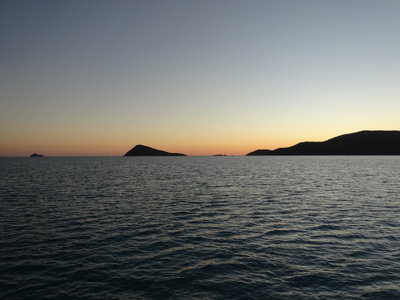 |  |
Sunrise at Nelly Bay looking towards
Saddleback Island and George Point | Kangaroo or wallaby tracks on the beach |
We get up at 0745 and at 0800 we take Veto to the beach. She has a good run around. Straight behind the beach are houses, this is Dingo Beach. When we get back on Catlypso we have breakfast and then put out on the foredeck things that need to dry. This includes the spinnaker, the doona and also one of the lounge bases which got wet from the spinnaker. Kelly also does some clothes washing. It is an almost perfect morning (which of course will not last long).
By 1100 the wind is easterly at 20 knots. We decide to go back to Gloucester Passage where it will be protected. We are also going to have dinner with Jillian and Wayne at one of the resorts. We leave at 1140 and motor around, it is a comfortable trip as the wind is mostly behind us. The wind varies from 12 to 22 knots, it was 25 to 27 knots just as we left.
 |
| A panoramic photograph of Nelly Bay from the beach. Gloucester Island at left, Manta Ray next to right and then Saddleback Island |
We anchor at 1300 about 30 metres south-east of where we were last time we were here. We are in 2.9 metres (under our hulls) and the tide will go down about another 0.8 metre. The wind is only 10 to 15 knots now, but later it comes up to 20 or so. The water is flat as we are only 50 metres or so off the beach.
We have lunch and then Kelly decides to defrost the two freezers. This has not been done since we left Sydney over four months ago. She also throws out some food items which we brought from Sydney and do not seem to be looking too good.
Wayne and Jillian arrive in Walkabout and anchor behind us. We go over later on the way to taking Veto for a walk and arrange to meet at Cape Gloucester Eco Resort at 1800 for dinner. Another yacht comes in and anchors next to us, it is Giselle, owned by Ian and Sue who Wayne and Jillian later meet on the beach and invite to dinner.
After our walk we have showers and just before 1800 take Thunderbird 2 to shore and moor her just off the entrance to the resort. The others arrive soon after us and we have a drink and then sit down for dinner. The food here is very good, and also reasonably priced. Michael again has the crocodile and Kelly the barramundi.
 |
| Dinner at the Eco Resort, Michael, Kelly, Jillian, Wayne, Sue and Ian |
South Sydney is playing the last regular game of the season, this time against Eastern Suburbs (Michael refuses to call them by their new name). He keeps an eye on what is happening via an iPhone app. His sister Janelle and her husband and kids are out there as is his brother Stephen. Unfortunately Souths play pathetically for the third week in a row. It does not seem to be the same team that we watched beat North Queensland Cowboys three weeks ago in Townsville. No way they can win the competition this year.
We have a great evening (apart from Souths getting beaten) with some very nice people. We head back to Catlypso about 2145.
Stats:
Saturday 5 September 2015 - Gloucester Passage to Double Bay East
It was calm overnight and sunny when we get up at 0800. Michael puts the watermaker on and we take Veto to the beach. When we get back, Michael adds 5 litres of petrol to Thunderbird 2's tank and then attempts to grease the steering which has again become stiff. However, he fails as it seems the grease nipple is blocked. He will need to remove and clean it. A job for another day!
Also, when Michael pulls up Thunderbird 2 onto the davits, the ropes slip as one of the pulleys got jammed. He has to redo the ropes again (too hard to explain what the problem is but we need to redo totally how it works). We then finally have breakfast. Michael then transfers 60 litres of water from containers to the forward starboard water tank which is the one we have been using. He needs to do this so he can fill them up from the watermaker (you cannot put water from the watermaker into that tank).
 | 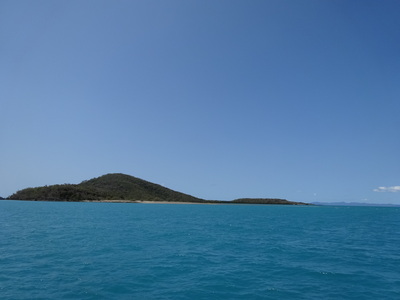 |
| Saddleback Island as we pass to the east of it | The southern side of Grassy Island |
We leave at 1030 and after saying goodbye to everyone on Giselle (Wayne and Jillian are visiting), we motor into Gloucester Passage. As we come to the dogleg outside Montes Resort, two large cruisers come in. Behind them are three identical cruisers who are obviously together. Of the five, three totally ignore the channel markers. It is lucky that they did not run aground considering where they went.
We motor out past Saddleback Island as the wind is from the east and we are heading east. Once we round George Point we can nearly sail as the wind is about 50ΒΊ off our nose. A bit further on it goes to 60ΒΊ so we pull out the genoa. However, the wind is quite variable, so we keep one engine on. We pass to the east of Olden Island and west of Grassy Island.
As we turn at Grassy Island we pull in the genoa and motor the rest of the way. We go into Double Bay East (there is a west one as well, hence Double Bay) and go almost to the end on the eastern side. We anchor in 4.1 metres just off the shore and near a small beach. This is a nice spot, with huge hills to the south-west and 200 metre high hills to our east. The water is very flat.
 |  |
| Kelly on the western beach at Double Bay | The water tank behind the beach |
We have lunch and then go to the larger beach on the western side of the bay. It is a bit over a nautical mile across but the bay is calm even over there (good considering wind is from east). The sand on this beach is very fine and you sink in as you walk. There are also the remains of what appears to be a house (water tank and some items like fridge).
 | 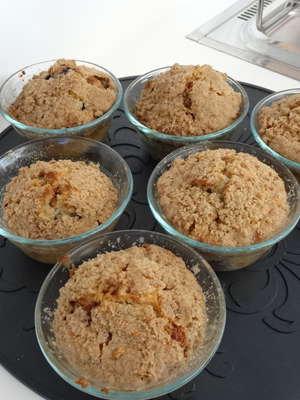 |
| Catlypso in Double Bay | The muffins Kelly cooked |
When we get back to Catlypso, Michael adds 44 litres of diesel to the main tank. All our containers are now empty so we will need to get some at Cannonvale some time in the near future. Meanwhile, Kelly cooks some muffins and makes curry chicken for dinner. Michael finally turns off the watermaker after 8 hours and 20 minutes, the longest we have ever run it. We figure that we made about 180 litres and we have full tanks. We have been a bit extravagant the past week, having hot showers every day.
We take Veto to the beach again, this time a small one near us. When we get back, Michael has a shower (Kelly decides she has had enough this week) and then sundowners followed by the curry chicken and rice.
Stats:
Sunday 6 September 2015 - Double Bay East to Luncheon Bay
It was very calm overnight and sunny with a slight southerly breeze when we get up at 0800. We take Veto to the closest beach for a run and then have breakfast. We have decided to spend the next few days out at the Whitsunday Islands as the wind will not be suitable for heading south. After this there will be at least a few days of bad weather (strong southerly winds) so we will spend that time at Airlie Beach refuelling and victualling.
We pull up the main before we leave the anchorage and find it is very hard. We have no idea why, we have to use the winch for nearly the whole sail. Anyway, we leave anchor at 0925 and motor out of the bay. Once outside we put out the genoa and sail towards the northern end of Hayman Island. The wind is about 10 to 16 knots close hauled and we make about 4 to 6.5 knots. The seas are flat.
Along the way we have morning tea and try the muffins Kelly made yesterday. They are a resounding success, very moist and tasty.
 |  |
| Catlypso in Double Bay from the nearest beach | Sailing towards Hayman Island |
Around 1130 the wind goes up to 21 knots and goes south-south-east which means it is on the beam. We are now doing 6.5 to 7.5 knots. As we approach Blue Pearl Bay on Hayman Island at 1230 the wind drops back to 15 knots. We have never seen so many boats there, many are anchored as there are only a few moorings. As we round Dolphin Point the wind drops to 5 knots so we pull in the genoa and put on an engine.
Soon we have to pull down the main, but we have a lot of problems as it is sticking. Kelly eventually gets it down, but it is hard work (Michael cannot really do it as his right hand is still recovering from the rope burns). We motor from here, heading towards Butterfly Bay. However, all the moorings are taken there as well as at Maureens Cove.
We head to Luncheon Bay and grab the northern-most mooring. This is for larger boats and the mooring line is extremely long, like the one at Manta Ray Bay that got tangled around our rudder and keel over a month ago. We end up shortening it by putting our bridle through the loop under the mooring buoy. Shithouse design (as we have said before).
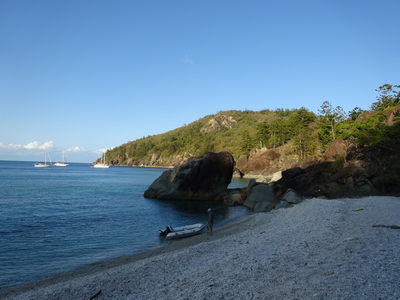 |  |
| Michael on the coral beach in Luncheon Bay | Looking out from the beach over Luncheon Bay |
We have lunch and relax and later go to the beach at the western end of the bay. This is totally made from coral and very steep (it is the one where a helicopter landed last time we were here). We go back to Catlypso and Kelly enjoys a hot shower while Michael gets sundowners ready. After this we have a barbecue of steak and sausages with fried rice.
It is a bit sloppy here, the wind has gone northerly which means there is no protection. Luckily it is not all that strong.
Stats:
Monday 7 September 2015 - Luncheon Bay to Whitehaven Beach
It was quite rolly during the night, but not as bad as it could have been. We slept reasonably well, but it certainly could have been better if the weather was as per the forecast. We get up at 0800 when it is a lot calmer and sunny. We go to the nearest beach (also coral) which is sort of hidden at high tide by some large boulders. Kelly has a swim, the water is the cleanest we have seen it here.
We have breakfast and again head off fairly early at 0930. We motor out around Pinnacle Rocks to the eastern side of Hook Island and once we get out a bit, we pull out the screecher. The wind is 17 to 20 knots, well above the forecast 10 to 15 knots. We are doing about 5 knots. The wind later drops to 13 to 15 knots but turns a bit more to the north meaning that our speed stays roughly the same. The tall ship charter boat Solway Lass passes us under full sail heading north.
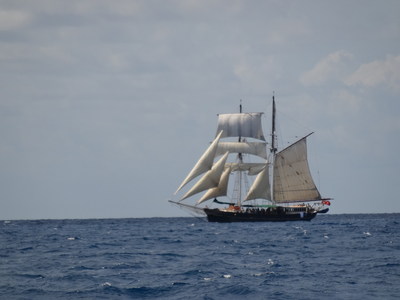 |  |
| Solway Lass passes us under full sail | Catlypso from Whitehaven Beach |
The seas are quite sloppy and the wind drops at times to under 10 knots meaning an engine has to be put on every now and then. At 1110 we pass Border Island and the wind goes around to the south-east. We pull in the screecher and motor. Later we pull out the genoa for a while but then the wind again goes back on the nose. We motor the rest of the way to Whitehaven Beach.
Whitehaven Beach is about seven kilometres long and is considered one of Australia's most beautiful beaches. We head to the southern end and anchor in about 3.1 metres. We are the northern-most of the boats anchored here, there are probably 20 in total, although some are day tourist boats that only stay for a short time before being replaced by others.
We have lunch and watch as a large sea plane lands behind us and drops off six passengers on the beach. It takes off and does a big loop around, flying back along the beach at less than 100 feet. The passengers remain on the beach enjoying the water and beach.
 |
| A panoramic photograph of Whitehaven Beach |
Michael also decides to do a permanent fix on the dinghy davit set up. The problem is that the current set up has a single rope that runs from one set of clips (which attaches to the bow) through the various pulleys and to the main rope (via an eye) and then back through the pulleys to the stern clips. Even though this is tied off on the eye with cable ties, over a period of time this slips (or slips suddenly if there is a jam) and the whole setup is then out of balance meaning the dinghy comes up lopsided.
What Michael has decided to do is make two separate ropes which then connect to the eye in the main rope. This means they will not slip. He finds an old halyard in the rope locker that seems to be the same diameter as the existing rope. He lowers Thunderbird 2 and then working from the dinghy removes the existing rope and reattaches it to the stern as part of the new setup. He then attaches a new line to the bow. It takes a few goes to get the length exactly right but it seems to be working. Tomorrow when it is calmer, Kelly will need to redo the knots as Michael cannot do them properly due to his sore hand.
 |  |
| Kelly wrote this in the sand | The sea plane takes off |
Later we go ashore and walk along part of the beach, the sand is very fine, certainly the best on any of the beaches around here. The sea plane comes back and lands near us and collects its passengers and then takes off again. A very civilised (if not expensive) way to see Whitehaven Beach.
We come back to Catlypso and Michael has a shower and then we have sundowners. Kelly makes bacon wrapped chicken breast and roast vegies.
Stats:
Click here for next part
Return to Our Yachting Adventures
| 
 v6.00.307 © 2003-2005
v6.00.307 © 2003-2005